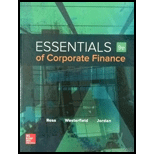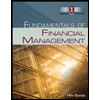
Essentials of Corporate Finance (Mcgraw-hill/Irwin Series in Finance, Insurance, and Real Estate)
9th Edition
ISBN: 9781259277214
Author: Stephen A. Ross Franco Modigliani Professor of Financial Economics Professor, Randolph W Westerfield Robert R. Dockson Deans Chair in Bus. Admin., Bradford D Jordan Professor
Publisher: McGraw-Hill Education
expand_more
expand_more
format_list_bulleted
Question
Chapter 13, Problem 13.3C
Summary Introduction
To discuss: The assumptions that are needed for M&M proposition I hold.
Introduction:
M&M proposition I is a proposition where the firm’s value is independent of the capital structure of the firm.
Expert Solution & Answer
Explanation of Solution
M&M proposition I states that how a company selects to arrange its finances is fully irrelevant; the fundamental assumption of M&M proposition I is that the corporations and individuals borrow at the same rate.
Conclusion
M&M proposition I is irrelevant because it is independent of the firm’s capital structure.
Want to see more full solutions like this?
Subscribe now to access step-by-step solutions to millions of textbook problems written by subject matter experts!
Students have asked these similar questions
The Efficient Market Hypothesis (EMH) suggests that:
a) All information is publicly available, but not necessarily reflected in stock pricesb) Stocks are always mispriced in the short termc) All public information is fully reflected in stock pricesd) Investors can achieve higher returns through technical analysis
Don't use ai tool please .
What is the primary purpose of diversification in a portfolio?
a) To maximize returnsb) To reduce riskc) To increase leveraged) To focus on a single asset class
Don't use chatgpt.
A company’s weighted average cost of capital (WACC) is used to:
A) Determine the average cost of producing goods
B) Evaluate the return on investment projects
C) Estimate the company's growth rate
D) Measure the level of debt in the company
Chapter 13 Solutions
Essentials of Corporate Finance (Mcgraw-hill/Irwin Series in Finance, Insurance, and Real Estate)
Ch. 13.1 - What is the relationship between the WACC and the...Ch. 13.1 - Prob. 13.1BCQCh. 13.2 - Prob. 13.2ACQCh. 13.2 - Prob. 13.2BCQCh. 13.2 - Prob. 13.2CCQCh. 13.3 - What does MM Proposition I state?Ch. 13.3 - Prob. 13.3BCQCh. 13.3 - Prob. 13.3CCQCh. 13.4 - Prob. 13.4ACQCh. 13.4 - Prob. 13.4BCQ
Ch. 13.5 - Prob. 13.5ACQCh. 13.5 - Prob. 13.5BCQCh. 13.6 - Can you describe the tradeoff that defines the...Ch. 13.6 - What are the important factors in making capital...Ch. 13.7 - Prob. 13.7ACQCh. 13.7 - Prob. 13.7BCQCh. 13.8 - What is the APR (in connection with bankruptcy...Ch. 13.8 - What is the difference between liquidation and...Ch. 13 - Prob. 13.3CCh. 13 - Prob. 13.4CCh. 13 - Prob. 13.5CCh. 13 - Section 13.6The static theory of capital structure...Ch. 13 - Prob. 13.7CCh. 13 - Business Risk versus Financial Risk. Explain what...Ch. 13 - Prob. 2CTCRCh. 13 - Prob. 3CTCRCh. 13 - Prob. 4CTCRCh. 13 - Prob. 5CTCRCh. 13 - Prob. 6CTCRCh. 13 - Prob. 7CTCRCh. 13 - Prob. 8CTCRCh. 13 - Prob. 9CTCRCh. 13 - Prob. 10CTCRCh. 13 - EBIT and Leverage. Kaelea, Inc., has no debt...Ch. 13 - EBIT, Taxes, and Leverage. Repeat parts (a) and...Ch. 13 - Prob. 3QPCh. 13 - Break-Even EBIT. Kyle Corporation is comparing two...Ch. 13 - Prob. 5QPCh. 13 - Prob. 6QPCh. 13 - Prob. 7QPCh. 13 - Prob. 8QPCh. 13 - Homemade Leverage. Lydie Enterprises is...Ch. 13 - Calculating WACC. Crosby Industries has a...Ch. 13 - Calculating WACC. Malkin Corp. has no debt but can...Ch. 13 - Prob. 12QPCh. 13 - Prob. 13QPCh. 13 - Prob. 14QPCh. 13 - MM. In the previous question, what is the...Ch. 13 - Prob. 16QPCh. 13 - Prob. 17QPCh. 13 - Prob. 18QPCh. 13 - Prob. 19QPCh. 13 - Business and Financial Risk. Assume a firms debt...Ch. 13 - Prob. 1CCCh. 13 - Prob. 2CCCh. 13 - Stephenson Real Estate Recapitalization Stephenson...Ch. 13 - Prob. 4CCCh. 13 - Prob. 5CC
Knowledge Booster
Similar questions
- What is the primary purpose of diversification in a portfolio? a) To maximize returnsb) To reduce riskc) To increase leveraged) To focus on a single asset classarrow_forwardI need help! A company’s weighted average cost of capital (WACC) is used to: A) Determine the average cost of producing goods B) Evaluate the return on investment projects C) Estimate the company's growth rate D) Measure the level of debt in the companyarrow_forwardNeed help!! What does the term "liquidity" refer to in finance? A) The ability to convert assets into cash quickly without significant loss of value B) The ability to increase company profits C) The level of debt in the company D) The diversity of the investment portfolioarrow_forward
- I need answer step by step. A company’s weighted average cost of capital (WACC) is used to: A) Determine the average cost of producing goods B) Evaluate the return on investment projects C) Estimate the company's growth rate D) Measure the level of debt in the companyarrow_forwardDon't use ai A company’s weighted average cost of capital (WACC) is used to: A) Determine the average cost of producing goods B) Evaluate the return on investment projects C) Estimate the company's growth rate D) Measure the level of debt in the companyarrow_forwardA company’s weighted average cost of capital (WACC) is used to: A) Determine the average cost of producing goods B) Evaluate the return on investment projects C) Estimate the company's growth rate D) Measure the level of debt in the companyarrow_forward
- I need help! Which of the following best defines "diversification" in investment? A) Investing in a single type of asset for high returns B) Spreading investments across different assets to reduce risk C) Putting all funds into low-risk bonds D) Focusing on high-risk, high-return investmentsarrow_forwardWhich of the following best defines "diversification" in investment? A) Investing in a single type of asset for high returns B) Spreading investments across different assets to reduce risk C) Putting all funds into low-risk bonds D) Focusing on high-risk, high-return investmentsarrow_forwardWhich of the following best describes the "efficient market hypothesis"? A) Stocks are always priced higher than their actual value. B) It is impossible to outperform the market consistently due to all information being already reflected in stock prices. C) Only insider information can help outperform the market. D) The market reacts slowly to new information.arrow_forward
- The "time value of money" concept states that: A) Money today is worth more than the same amount in the future B) Money tomorrow is worth more than today’s money C) Money and time have no relation in financial decisions D) Time has no impact on financial investmentsarrow_forwardI need help. If net income is $25,000 and total equity is $125,000, what is the return on equity (ROE)?A. 10%B. 15%C. 20%D. 25%arrow_forwardI need help!!Which of the following is NOT a type of financial market? A) Capital Market B) Money Market C) Labor Market D) Commodity Marketarrow_forward
arrow_back_ios
SEE MORE QUESTIONS
arrow_forward_ios
Recommended textbooks for you
 Fundamentals of Financial Management (MindTap Cou...FinanceISBN:9781285867977Author:Eugene F. Brigham, Joel F. HoustonPublisher:Cengage Learning
Fundamentals of Financial Management (MindTap Cou...FinanceISBN:9781285867977Author:Eugene F. Brigham, Joel F. HoustonPublisher:Cengage Learning Intermediate Financial Management (MindTap Course...FinanceISBN:9781337395083Author:Eugene F. Brigham, Phillip R. DavesPublisher:Cengage Learning
Intermediate Financial Management (MindTap Course...FinanceISBN:9781337395083Author:Eugene F. Brigham, Phillip R. DavesPublisher:Cengage Learning EBK CONTEMPORARY FINANCIAL MANAGEMENTFinanceISBN:9781337514835Author:MOYERPublisher:CENGAGE LEARNING - CONSIGNMENT
EBK CONTEMPORARY FINANCIAL MANAGEMENTFinanceISBN:9781337514835Author:MOYERPublisher:CENGAGE LEARNING - CONSIGNMENT



Fundamentals of Financial Management (MindTap Cou...
Finance
ISBN:9781285867977
Author:Eugene F. Brigham, Joel F. Houston
Publisher:Cengage Learning

Intermediate Financial Management (MindTap Course...
Finance
ISBN:9781337395083
Author:Eugene F. Brigham, Phillip R. Daves
Publisher:Cengage Learning

EBK CONTEMPORARY FINANCIAL MANAGEMENT
Finance
ISBN:9781337514835
Author:MOYER
Publisher:CENGAGE LEARNING - CONSIGNMENT